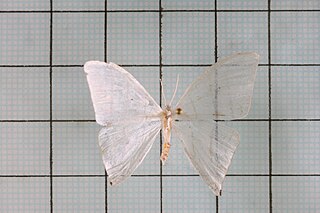
Morelia is a genus of large snakes in the family Pythonidae found in Indonesia, New Guinea, and throughout Australia. Currently, up to eight species are recognized.

Morelia spilota, commonly referred to as the carpet python, is a large snake of the family Pythonidae found in Australia, New Guinea, Bismarck Archipelago, and the northern Solomon Islands. Many subspecies are described; ITIS lists six, the Reptile Database six, and the IUCN eight.
The blotched mogurnda is a species of fish in the family Eleotridae endemic to Lake Kutubu. This species can reach a standard length of 13 cm (5.1 in).

Morelia spilota spilota is a subspecies of carpet python, popularly known as the diamond python. It is a medium to large snake, found in coastal areas and adjacent ranges of south-eastern Australia. It is the most southerly occurring python in the world and is found at higher altitudes than any other species of Australian python.

Morelia spilota variegata, commonly known as Torresian carpet python, Darwin carpet python or northwestern carpet python, is a subspecies of python found in New Guinea and Australia, smaller than the nominate subspecies Morelia spilota spilota and has a more restricted geographic range.

Ditrigona is a genus of moths belonging to the subfamily Drepaninae. The genus was erected by Frederic Moore in 1888.
Anumeta spilota is a moth of the family Erebidae first described by Nikolay Grigoryevich Erschoff in 1874. It is found from the western parts of the Sahara to the Sinai, Israel, central Asia, Pakistan and India.

Ditrigona conflexaria is a moth in the family Drepanidae. It was described by Strand in 1917. It is found in China, Japan and Taiwan.
Ditrigona wilkinsoni is a moth in the family Drepanidae. It was described by Jeremy Daniel Holloway in 1998. It is found on Borneo and possibly Peninsular Malaysia.
Ditrigona diana is a moth in the family Drepanidae. It was described by Wilkinson in 1968. It is found in north-eastern India (Assam) and Bhutan.
Ditrigona platytes is a moth in the family Drepanidae. It was described by Wilkinson in 1968. It is found in China.
Ditrigona sericea is a moth in the family Drepanidae. It was described by John Henry Leech in 1898. It is found in China, Myanmar and north-eastern India.
Ditrigona fasciata is a moth in the family Drepanidae. It was described by George Hampson in 1893. It is found in Sikkim, India.
Ditrigona obliquilinea is a moth in the family Drepanidae. It was described by George Hampson in 1892. It is found in Myanmar, India and China.
Ditrigona jardanaria is a moth in the family Drepanidae. It was described by Oberthür in 1923. It is found in western China and possibly Tibet.
Ditrigona komarovi is a moth in the family Drepanidae. It was described by Alekseya Ivanovitch Kurentzov in 1935. It is found in Ussuri in the Russian Far East.
Ditrigona quinaria is a moth in the family Drepanidae. It was described by Frederic Moore in 1867. It is found in China, Tibet and India.
Ditrigona regularis is a moth in the family Drepanidae. It was described by Warren in 1922. It is found in India (Assam) and Burma.
Ditrigona pruinosa is a moth in the family Drepanidae. It was described by Frederic Moore in 1888. It is found in Darjeeling, India. The Global Lepidoptera Names Index lists it as a synonym of Ditrigona quinaria.





